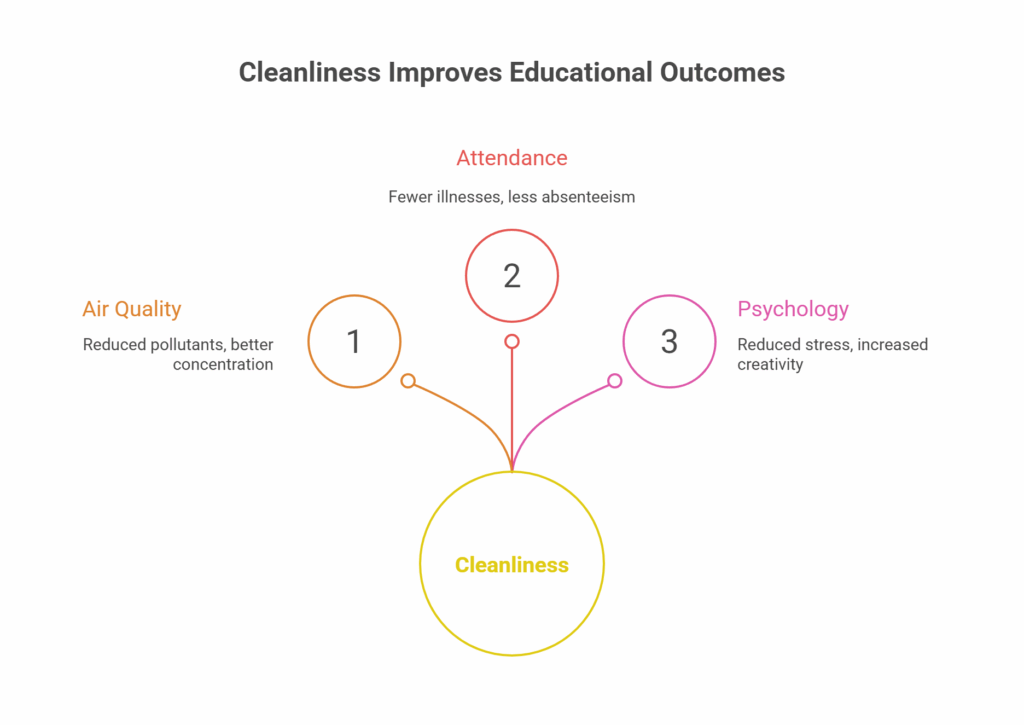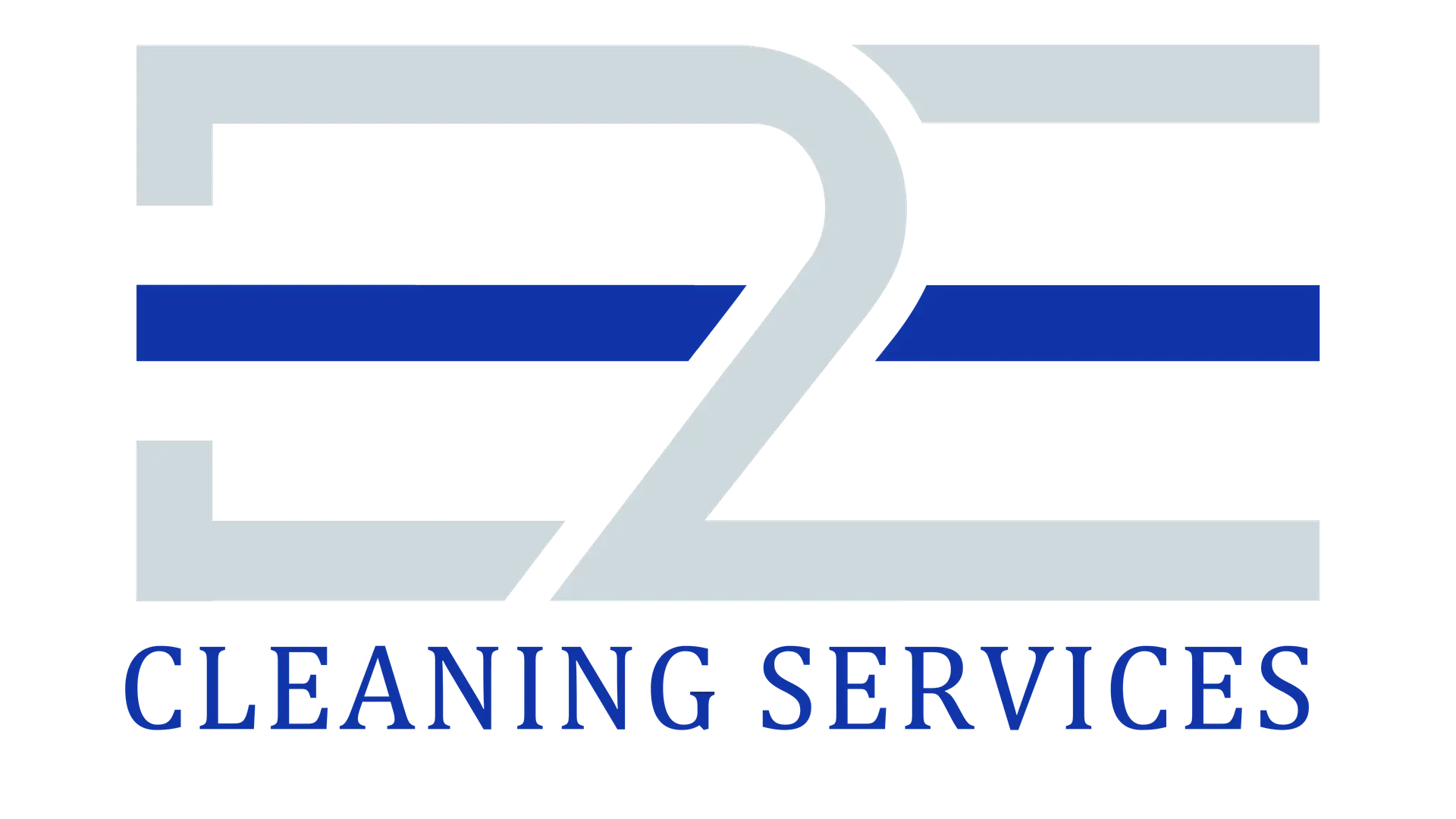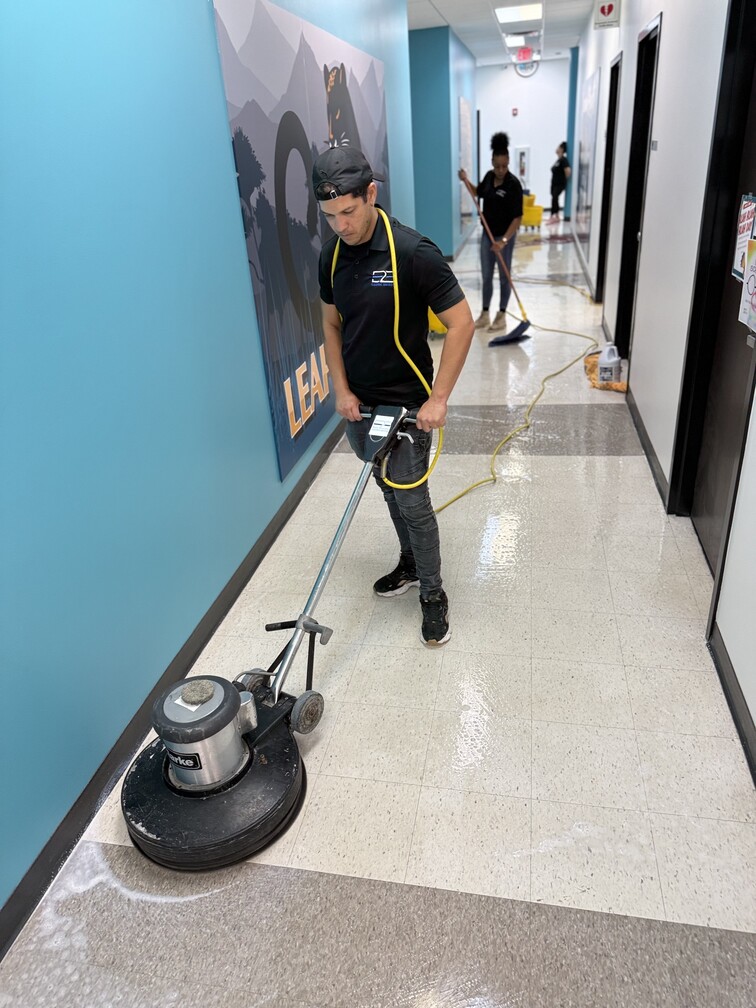The current discussion summarizes the significant impact that school cleanliness has on educational outcomes based on the research carried out up to 2025. The review assesses the short-term impacts of professional janitorial services on student health, attendance and academic performance.
From ATP monitoring shows that the number of illness-related absences decreased by 9%, to APPA studies showing that 88 % of students are distracted by dirty environments.
All these findings prove that school cleaning is in fact an investment in education. This article provides facility managers and cleaning professionals with effective protocols, measurement strategies, and ROI calculations to enable the implementation of effective educational cleaning programs.
The Hidden Connection Between Cleanliness and Learning
There is a hidden connection between cleanliness and learning. Look at two identical classrooms, one is well taken care of-clean floors, clean windows, halls smelling of pleasant aromatics.
The other shows scuffed tiles, dust, and smells of the bathroom that can be felt in the corridors. Before even the first lesson, both environments send a different message regarding institutional values and the value of the students.
The correlation between clean schools and effectiveness of education is empirical and unquestionable. The Association of Physical Plant Administrators (APPA) and the International Sanitary Supply Association (ISSA) found in a survey of 1,481 pupils that 88 percent of those surveyed become distracted when cleanliness is compromised.
When restrooms and shared areas fall below basic cleanliness standards, measurable academic performance decrease can occur.
Poor cleanliness creates measurable impacts on health indicators, attendance rates, cognitive skills, and behavior. For facility managers and cleaning professionals, custodial work extends far beyond basic maintenance, it directly supports the learning and working environment.
The Science Behind Clean Learning Environments
The connection between the cleanliness of facilities and educational success is rooted in three main areas of science.

Air Quality and Cognitive Function:
Research by EPA has shown that indoor air in schools on average is 2-5 times worse than outdoor air. Poor cleaning practices continue to spread dust, allergens, and other particulates that are transferred through ventilation systems.
According to Princeton University, the idea that visual clutter and associated environmental pollutants are directly harmful to concentration and information processing.
Conversely, schools that have adopted Green Seal-certified cleaning have reported dramatic improvements in the measures of indoor air quality, and the positive effects can be quantified in terms of student achievement, especially during high-stakes testing when the capacity to sustain a high level of concentration is most important.
Reduced Illness and Improved Attendance:
A groundbreaking 2022 study released in the peer-reviewed journal PLOS ONE used ATP (adenosine triphosphate) monitoring to measure the level of surface contamination in intervention and control schools.
The results were dramatic: the schools where desktop cleaning was done twice a week with effective disinfectants had a statistically significant decrease in the number of gastrointestinal illness-related absences (p=0.042).
The model affirmed that improved cleaning measures lowered the vectors of diseases. Similarly, schools that employ Green Seal-certified cleaning products record reduced asthma and respiratory-related absenteeism- one of the most common causes of chronic absenteeism in K-12 schooling.
Psychological Impact of Organized Spaces:
Research in environmental psychology has confirmed that the physical environment has a significant effect on the mind. According to Princeton studies, cluttered and dirty surroundings force the brain to process too much visual information and hence consume cognitive resources that are essential in the learning process.
Students who sit in clean and organized spaces have better concentration, reduced stress indicators, and increased creativity. When asked about the obstacles to learning, they regularly mention visible dirt, smells and clutter as their top distractions.
All issues that are directly resolved by professional cleaning services.
These scientific evidences explain why schools that have thorough cleaning regimes always outperform those that have minimal maintenance in terms of health and academic performance.
Unlock Better Student Performance Through Cleanliness.
How Professional Janitorial Services Transform Schools
Professional janitorial services provice systematic protocols that go beyond the basic mop and bucket methods.
Daily Maintenance Routines:
Effective school-cleaning programs use tiered cleaning schedules that are based on intensive risk assessment. Doorknobs, light switches, and shared technology are high-touch surfaces that are disinfected several times a day. Bathrooms in large schools require cleaning at least twice or thrice daily.
Common areas and corridors benefit by having constant surveillance and a prompt reaction to spills or litter.
This regular intervention eliminates the cumulative effect of soil accumulation, which exponentially increases in difficulty to eliminate after 48 hours.
Specialized Cleaning Protocols:
Educational settings have special needs that necessitate special knowledge. The ISSA Clean Standard for K-12 Schools is used by professional service providers and includes:
- Cleaning systems made of microfiber that traps 99.9 % of microorganisms, as opposed to the 30 % of cotton-based systems
- Zone cleaning that prevents cross contamination between high risk areas (restrooms) and learning spaces
- Separation of distinct areas by color-coded tools and supplies
- EPA-approved disinfectants, with the right dwell times, which are specifically chosen in educational facilities
- Improved ventilation control when cleaning up
Equipment and Techniques:
The cleaning of modern schools is based on the use of high-tech equipment that increases efficiency and minimizes harm to the environment:
- HEPA-filtered backpack vacuums which trap 99.97 % of the 0.3-micron particles
- ATP monitors that give measurable cleanliness confirmation
- Electrostatic sprayers which provide uniform coverage of disinfectant on irregular surfaces
- Auto-scrubbers using cylindrical brushes to clean the floor grout lines without unnecessary use of water
- Chemical dispensing systems that ensure the appropriate dilution rates that avoid ineffective cleaning and chemical waste
Such professional cleaning techniques guarantee that cleaning activities reduce pathogen loads, as opposed to simply redistributing the contaminants, which is a critical difference in educational buildings where health-vulnerable populations gather every day.
Floor Care: The Foundation of Learning Spaces
The floor forms the biggest surface in an educational facility whether it is a classroom, gymnasium or an office space; it has a significant impact on the health of the population and the image of the facility:
Impact on Safety and Health:
Cleanliness of the floor is directly proportional to the rate of accidents and indoor air quality. Poor maintenance is a factor in slip-and-fall accidents (the most common school injury claim), airborne particulate matter (floors can release trapped particles when they are disturbed by foot traffic), and allergen buildup (carpet can contain up to 100,000 dust mites per square yard when not maintained well).
Professional floor maintenance can counter these issues by performing systematic soil removal, proper finish selection, and maintenance that avoids the accumulation of contaminants.
Different Flooring Types and Care Requirements:
Educational buildings usually have a variety of flooring materials. Each one with specific needs and special maintenance procedures:
- Vinyl Composition Tile (VCT): Must be stripped and refinished periodically (usually 2-3 times per year), and daily dust mopped and weekly auto-scrubbed to retain protective finish.
- Carpet: Requires daily vacuuming using HEPA-filtered vacuum, quarterly hot-water extraction, and instantaneous spot treatment to avoid permanent staining.
- Terrazzo: Daily dust mopping and weekly machine scrubbing with neutral cleaners to avoid etching of the mineral composition.
- Rubber Flooring: (typical of gymnasiums) Needs special cleaners that will not harm the material, should avoid ammonia and high-pH solutions.
Creating Welcoming Environments:
In addition to the health factors, well-maintained floors establish psychological advantages. It has been scientifically proven that shiny floors give an instant impression of institutional pride and attention to detail.
Schools that have a thorough program of floor maintenance have shown an elevated level of community satisfaction rating and enrollment interest which is important in districts where funding is based on the number of students.
The quality of flooring is usually a visual shortcut to the quality of the entire facility, which affects student morale and community support.
Floor care is thus the core of successful school cleaning initiatives, and the effects of which can be measured both in terms of physical health and the perception of the institution.
The Janitor’s Role in Student Success
The role of custodians in schools and colleges extends beyond the physical upkeep of the buildings; it has a mutual impact on the achievement of students in various ways.
Beyond Cleaning: Custodians as Community Members:
Often, custodial staff are the most reliable adult on a school campus, interacting with students at all grade levels and noting behavioural patterns. This long-term interaction often results in unique relationships with students who are not able to succeed in traditional classroom settings.
This has led to the fact that experienced custodians usually act as informal mentors to those who want non-academic adult affiliations. This dual role strengthens the collective responsibility of the school environment.
Creating Environments for Focus and Learning:
The professionally trained custodial staffs are aware of the mutual dependence between environmental factors and cognitive performance and control temperature, humidity, noise, and lighting factors that have been known to influence mental acuity and alertness.
Major maintenance issues are addressed as they arise (i.e., flickering lights, squeaking doors, temperature differences), which helps to curtail distractions that take away mental concentration. This proactive service enables the instructors to focus on pedagogy instead of facility management.
Real-World Impact:
Professional janitorial servics can deliver measurable benefits:
- Schools using ISSA-certified cleaning programs reported 24 % fewer nurse visits for environmental irritants (2024 study of 42 schools).
- In other studies, the schools that implemented ATP monitoring procedures saw a 9 % decrease in absenteeism compared to control schools that used conventional cleaning validation.
- Similarly, the facilities which used Green Seal-certified practices had 18 % reduced asthma-related absenteeism and 12 % increased teacher retention.
All of these results have a direct impact on educational gains, with a typical elementary student earning 3.8 days of additional school time each year in thoroughly cleaned settings than in those with minimal maintenance.
As a result, the best educational cleaning programs do not view janitors as a peripheral service provider but rather as a critical part of the educational mission, people whose work makes student success possible.
Measuring the Clean School Effect
Quantifyting janitorial effectiveness helps facility managers show value and secure funding through measurable outcomes:
Academic Performance Correlations:
Clean facilities directly boost learning by:
- Schools maintaining high cleanliness standards score 5-7% higer on standarized tests
- Reading comprehension improves 4.5% when dust and allergens are controlled
- Math problem-solving increases 6.2% in properly ventilated, clean classrooms
Health and Attendance Improvements:
Professional cleaning reduces illness:
- Schools using ATP testing experience 14% fewer respiratory outbreaks
- Proper disinfection cuts gastrointestinal illness clusters by 22%
- Green cleaning reduces asthma incidents by 17% and chemical sensitivities by 25%
These health improvements can give students an average of 1.3 additional school days per year.
Teacher and Student Satisfaction:
Facility managers can measure results through:
- ATP testing of high-touch surfaces
- Air quality monitoring (particles, chemicals, Co2)
- Absence tracking linked to cleaning changes
- Environmental satisfaction surveys
These metrics prove that janitorial services are essential to educational sucess, justifying investment in quality cleaning programs.
Conclusion: Investing in Clean Schools is Investing in Education
The facts are indisputable and convincing: professional cleaning services have a direct impact on school achievement. By minimizing absenteeism due to proper disinfection and enhancing cognitive ability due to air quality control, clean schools provide the environment in which learning is possible.
The study shows that the investment in qualified Janitorial personnel, correct equipment, and evidence-based procedures is not only a facilities cost, but also an educational investment that can be measured in different ways.
Schools that adopt ISSA standards and ATP monitoring experience better test scores, increased attendance rates, decreased healthcare costs, and increased community satisfaction.
For facility managers and cleaning professionals, this knowledge changes the discourse of educational cleaning services.
Janitorial work is not an adjunct to education, but a central part of it. The custodian who comes in after hours to make sure the floors are shiny and the surfaces are clean is not just keeping a building in good shape, but facilitating tomorrow learning.
As we keep improving evidence-based cleaning in schools, we are not merely making them cleaner but we are making them better learning institutions. In a very real sense, the road to academic excellence starts with a well maintained and professionally cleaned learning environment.






